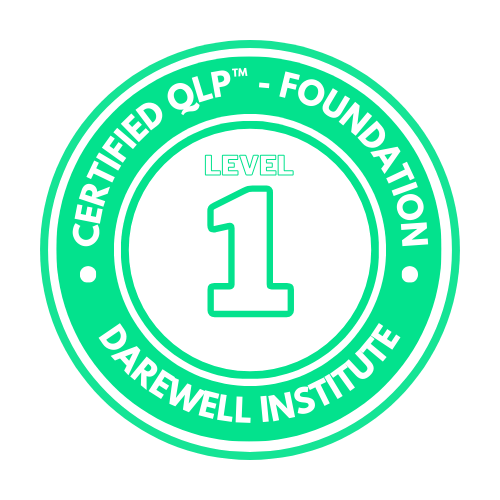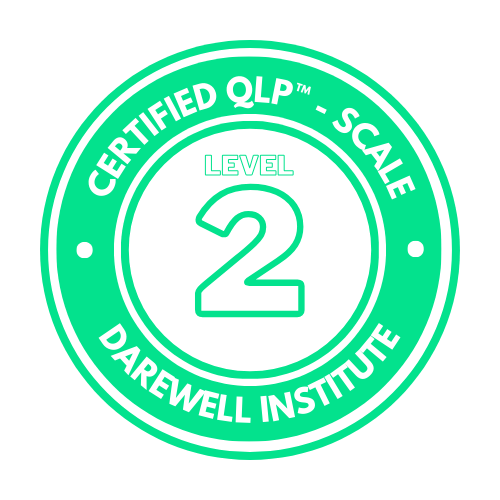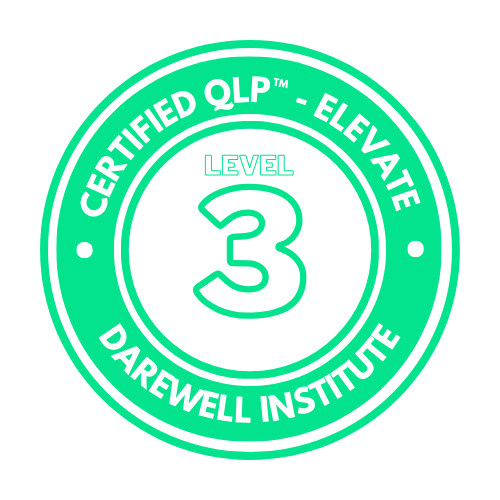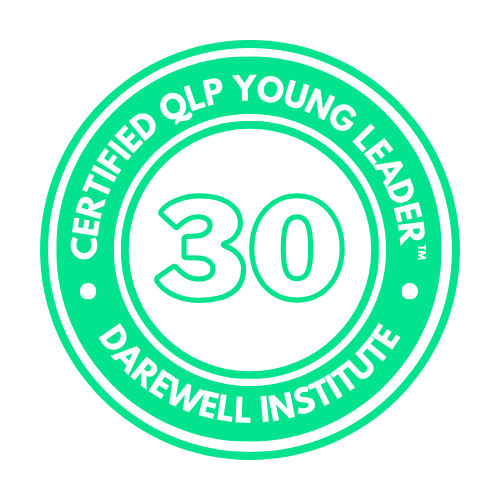Introduction to OKR
Everything You Need to Know About OKRs: From Strategy to Results, Efficiently
This article aims to introduce you to OKRs in their entirety, offering you a clear understanding of their benefits, how they compare to other performance management methods, and sharing some of the challenges associated with their implementation.
By understanding the specifics and advantages of OKRs, you will be better prepared to integrate them effectively into your organization.
In particular, you will discover:
Content
OKRs vs. Other Performance Management Methods: A Comparative Analysis
Performance Management in Business: Evolution and Comparison of Key Methods
Performance management in business has evolved over the decades, leading to the development of various methods, each with its own characteristics and benefits.
Here’s a comparative overview of the main performance management methods, including OKRs, to better understand their evolution and differences.
Balanced Scorecard (BSC)
Creation : 1992 by Robert Kaplan & David Norton.
Description: The Balanced Scorecard (BSC) is a performance management method that translates a company’s vision and strategy into a set of objectives linked to four key perspectives: Financial, Customer, Internal Processes, and Learning & Growth.
Differences: Unlike OKRs, the BSC focuses on balancing different dimensions of performance without necessarily setting measurable key results for each objective. It is broader and less flexible than OKRs.
SMART Goals
Creation : 1981 by George T. Doran.
Description: SMART goals are designed to be Specific, Measurable, Achievable, Realistic, and Time-bound. This method aims to clarify goals for better individual and organizational performance management.
Differences: SMART goals are often used for short-term projects or specific tasks, while OKRs are more dynamic, suited to a company’s strategic objectives, and encourage ambitious goals.
Management by Objectives (MBO)
Creation : 1954 by Peter Drucker.
Description: Management by Objectives (MBO) is a performance management method where goals are jointly set by managers and employees, aligned with the overall objectives of the company. Performance is evaluated based on the achievement of these goals.
Differences: MBOs often focus on annual goals with periodic evaluations, while OKRs are typically shorter-term, often quarterly, promoting more frequent reassessment and adjustment.
Key Performance Indicators (KPIs)
Creation: Used since the 1950s, popularized in the 1990s.
Description: Key Performance Indicators (KPIs) are quantitative metrics used to measure a company’s performance against its strategic and operational objectives. They are often specific to a particular area of the business.
Differences: KPIs are continuous performance metrics, whereas OKRs are specific objectives with measurable key results. OKRs can include KPIs as key results.
Objectives and Key Results (OKR)
Creation: Developed in the 1970s by Andy Grove at Intel, popularized by John Doerr at Google starting in the 2000s.
Description: OKRs (Objectives and Key Results) are a goal-setting method that allows organizations to define ambitious objectives and measurable key results. This approach promotes alignment, transparency, and employee engagement.
Differences: OKRs are designed to be transparent, scalable, and flexible, allowing for frequent adjustments and encouraging innovation and ambition. They stand out for their simplicity and ability to quickly adapt to strategic changes.
The Growing Popularity of OKRs in Europe and France
The interest in OKRs in Europe and France has evolved significantly in recent years, as illustrated by this Google Trends graph over the past 20 years.
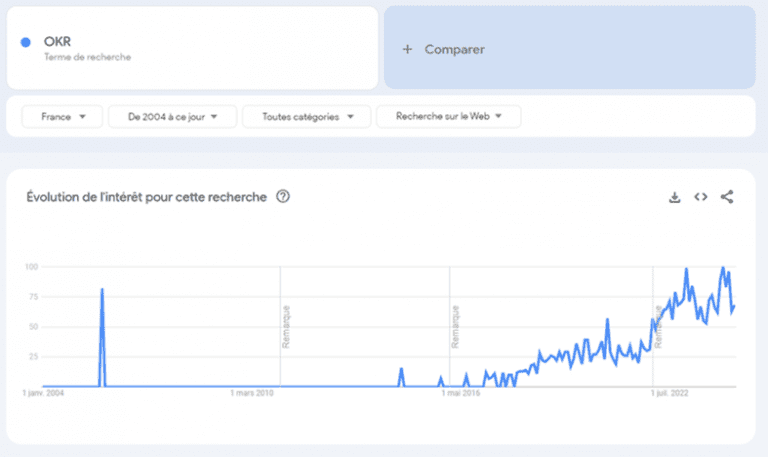
Of course, each performance management method offers specific advantages depending on the context and needs of the business.
However, OKRs stand out for their flexibility, transparency, and ability to inspire and align teams around ambitious goals.
Compared to other methods, OKRs promote frequent reassessment of objectives and a culture of continuous improvement, making them particularly well-suited to dynamic and rapidly changing environments.
With this comparative overview, we can now delve deeper into the benefits of OKRs and how they can transform your company’s performance.
What Are OKRs?
Definition
OKRs (Objectives and Key Results) are a goal-setting and tracking method designed to align individual and collective efforts with the company’s strategic vision. Created by Andy Grove at Intel and popularized by companies like Google, OKRs consist of two main elements:
Objectives: Qualitative statements that describe what you want to achieve. They should be clear, inspiring, and aligned with the company’s vision.
Example: “Improve the user experience of our mobile app.”
Key Results: Quantitative measures that indicate how you will know if you have achieved the objective. They should be specific, measurable, and time-bound.
Example for the above objective:
- Increase user satisfaction score from 4.0 to 4.5.
- Reduce uninstallation rate from 20% to 10%.
- Improve app loading speed from 3 seconds to 1 second.
Cascading and Aligning OKRs Across the Organization
OKRs are not limited to company-wide goals; they must be broken down and aligned across all levels of the organization to ensure consistency and engagement at every tier.
Here’s how it works:
Company OKRs: Defined by top management, these strategic objectives set the overall direction and priorities for the company. Example: “Become the market leader in our sector by 2025.”
Department OKRs: Each department creates OKRs that support the company OKRs. Example for the marketing department: “Increase brand awareness by 30%.”
Team OKRs: Teams within departments set their own OKRs in alignment with departmental OKRs. Example for a content team: “Launch a viral content campaign with a reach of 1 million people.”
Individual OKRs: Each employee sets personal OKRs that contribute to their team’s OKRs. Example for a content writer: “Write and publish 10 blog posts with an average engagement of 5 minutes per post.”
Cascading OKRs ensure that every member of the organization understands how their work contributes to overall objectives, fostering alignment, transparency, and accountability at all levels.
Note that there are two approaches: one suggesting cascading OKRs to the individual level and the other advocating for team-level OKRs to enhance collaboration. We generally recommend limiting OKRs to the team level to promote collaboration, with individual OKRs used for personal development.

Now That We Have a Comprehensive Understanding of OKRs, Let’s Explore Why They Are Essential for Businesses in 2024
Why OKRs Are Essential in 2024
OKRs (Objectives and Key Results) are not just a management tool but a method that operationalizes best practices in management, leadership, and corporate culture.
They uniquely and powerfully address the current and future challenges businesses face in 2024.
Here’s why:
Contribution to Employee Engagement Factors
Gallup’s report identifies six key factors of employee engagement, and OKRs can significantly contribute to each of them:
1. Belonging
Create a sense of belonging among employees. OKRs enhance this feeling by aligning personal and professional goals with the company’s vision. When employees see how their specific contributions help achieve overall goals, they feel more connected and integrated into the organization.
2. Corporate Social Responsibility
Take pride in the company’s efforts to make a positive impact on the world. OKRs can include objectives related to social and environmental responsibility, allowing employees to see and contribute directly to the company’s positive initiatives. This boosts employees’ pride and commitment to their employer.
3. Career Goals
Feel that career objectives can be achieved within the company. OKRs set ambitious goals that encourage employees to excel and develop new skills. With clear and measurable objectives, employees can track their progress and feel more confident about their career path within the company.
4. Trust in Top Management
Have confidence that top management is making the right decisions. OKRs introduce transparency into the goals and expected outcomes, allowing employees to see the direction taken by top management. This transparency strengthens employees’ trust in their leaders and the company’s strategic decisions.
5. Learning & Development
Access good opportunities for learning and development. OKRs provide a framework for setting personal and professional development goals, encouraging continuous learning and skill acquisition. Employees thus have clear opportunities for growth and development in their roles.
6. Adaptation to Change
Receive support to adapt to organizational changes. OKRs facilitate adaptation by providing a flexible and adaptable framework for setting and achieving goals. Employees are better prepared to adjust to new priorities and strategies due to clear objectives and regular feedback.
OKRs not only allow for long-term planning, as evidenced by the four-year horizon OKRs set by YouTube’s audience development team, but they can also be broken down into quarterly objectives for regular and adaptable tracking.
By leveraging OKRs, companies can set clear and ambitious goals while fostering a data-driven culture and continuous improvement, which are essential for success in 2024 and beyond.
OKRs Provide Concrete Solutions to Operational Challenges
1. Alignment of Objectives
Job to Be Done: Ensure that all departments and employees work towards objectives aligned with the company’s overall strategy.
Problem: It is often challenging to ensure that all departments and employees work towards objectives aligned with the company’s overall strategy. According to a Harvard Business Review study, only 7% of employees fully understand their company’s strategic objectives.
Solution with OKRs: OKRs help ensure that all levels of the organization are aligned with common objectives, minimizing redundant efforts and deviations from the primary mission.
Example: The IT team might set quarterly OKRs aligned with the higher goal of improving customer satisfaction.
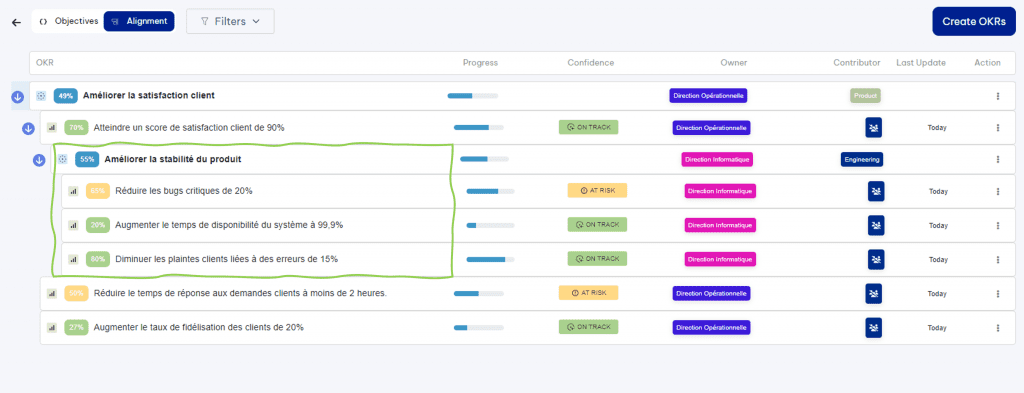
2. Improving Communication and Transparency
Job to Be Done: Facilitate clear and transparent communication regarding goals and progress.
Problem: Communication between teams and departments becomes more complex and less transparent. Gallup reports that 74% of employees often feel excluded from important decisions.
Solution with OKRs: OKRs facilitate clear and transparent communication about goals and progress, allowing everyone to understand how their work contributes to overall objectives.
Indeed, a key feature of OKRs is that goal alignment should be visible throughout the organization.
3. Prioritization and Focus
Job to Be Done: Help teams prioritize tasks and focus on the most important objectives.
Problem: Teams can be pulled in different directions by competing priorities, which can dilute efforts and reduce effectiveness. A McKinsey study reveals that employees spend, on average, 37% of their time on non-priority tasks.
Solution with OKRs: OKRs assist teams in prioritizing their tasks and focusing on the most critical objectives by clearly defining priorities through OKRs.
Example: Set specific Key Results for each objective, clearly indicating what needs to be accomplished to achieve success.
🎯 Objective: Launch a new product campaign.
✅ Key Result 1: Increase web traffic by 30%.
✅ Key Result 2: Generate 500 new qualified leads.
✅ Key Result 3: Achieve a conversion rate of 10%.
4. More Effective Meetings and Reduction in Their Number
Job to Be Done: Make meetings more focused and effective, reducing the number of necessary meetings.
Problem: Ineffective and overly frequent meetings can waste valuable time and slow down progress. According to an Atlassian report, employees spend about 31 hours per month in unproductive meetings.
Solution with OKRs: OKRs make meetings more focused and effective by providing a clear framework to discuss progress and obstacles, thus reducing the number of necessary meetings.
Example: Weekly team meetings can focus on OKR progress, challenges encountered, and necessary adjustments, facilitating clear and targeted communication.
🎯 Objective: Improve sales team performance.
✅ Key Result 1: Increase lead conversion rate by 15%.
✅ Key Result 2: Reduce average sales cycle by 10 days.
✅ Key Result 3: Achieve a quarterly revenue of 1 million euros.
5. Data-Driven Culture and Continuous Improvement
Job to Be Done: Establish a data-driven culture and encourage continuous improvement.
Problem: Companies may struggle to build a data-driven culture and foster continuous improvement. According to a Forrester study, 74% of companies want to become more data-focused, but only 29% successfully align data analysis with their business goals.
Solution with OKRs: OKRs promote a data-driven culture by continuously measuring progress and driving ongoing performance improvement.
Example: Implement quarterly OKR retrospectives to assess progress, analyze data, and adjust strategies.
🎯 Objective: Optimize customer support processes.
✅ Key Result 1: Increase ticket handling capacity by 25%.
✅ Key Result 2: Reduce critical incident resolution time by 50%.
✅ Key Result 3: Improve post-intervention satisfaction rate to 95%.
6. Development of Autonomy and Critical Thinking
Job to Be Done: Develop employee autonomy and encourage critical thinking.
Problem: Employees may lack autonomy and critical thinking, limiting their ability to contribute significantly to innovation and problem-solving. This issue can stem from personal factors or company culture. A Deloitte study shows that companies where employees feel autonomous and empowered exhibit a 20% higher performance.
Solution with OKRs: OKRs encourage employees (trained) to think about goals from a 360-degree perspective, thus developing their critical thinking skills and autonomy.
Example: Involve employees in defining OKRs for each team, promoting direct engagement in achieving set objectives.
Additionally, the method encourages individuals to consider complementary Key Results, both upstream and downstream, and the potential side effects of certain indicators.
🎯 Objective: Improve internal development processes.
✅ Key Result 1: Identify and document 5 major inefficiencies.
✅ Key Result 2: Propose and implement 3 innovative solutions.
✅ Key Result 3: Reduce average development time by 20%.
With these concrete benefits, it’s clear why OKRs are gaining increasing popularity in modern organizations.
However, beyond being just a tool, OKRs require certain skills and attitudes that need to be developed to optimize their results.
In the following section, you will find some common obstacles and suggestions for overcoming them.
Challenges in Deploying OKRs
Implementing OKRs (Objectives and Key Results) in a company, while potentially very beneficial, can also present several challenges.
Here is a more in-depth analysis of the common obstacles organizations may face when deploying OKRs:
Resistance to Change
Problem: Employees and managers may resist adopting new performance management and measurement methods, especially if these represent a radical shift from existing practices.
Solution:
- Communication and Training: Clearly explain the benefits of OKRs and provide adequate training.
- Leadership and Sponsorship: Secure support from leadership to encourage adoption.
- Pilot Phase: It is advisable to start with a pilot phase involving one team to adjust the processes according to the organization before scaling up.
Alignment and Consistency
Problem: Ensuring alignment of OKRs at all levels of the company can be complex. Objectives must be consistent with the company’s strategic vision and cascade effectively through different teams.
Solution:
While implementing OKRs requires a time investment, it is crucial to maintain a streamlined process that integrates seamlessly with current practices without adding extra workload.
However, here are some ideas to facilitate alignment:
- Workshops and Alignment Sessions: Organize workshops to align objectives across departments.
- Visualization Tools: Use tools that help visualize how OKRs connect and support each other.
Defining Effective OKRs
Problem: Formulating effective OKRs is a skill that requires practice. Objectives need to be ambitious yet achievable, and key results must be measurable.
Solution:
- Clear Guidelines: Provide guidelines and examples of best practices.
- Continuous Feedback: Encourage a regular feedback cycle to refine OKRs.
Tracking and Measurement
Problem: Tracking OKR progress and measuring results consistently and regularly can be challenging, especially without the right tools or processes in place.
Solution:
- Tracking Tools: Use specialized software to monitor OKRs in real-time.
- Regular Reviews: Implement regular reviews to assess progress and adjust actions as needed.
Culture of Continuous Improvement
Problem: Creating a culture where learning and continuous improvement are valued requires organization-wide commitment.
Solution:
- Encourage Innovation: Promote experimentation and learning from mistakes.
- Share Successes: Regularly share successes and lessons learned from OKRs.
Integration with Other Management Methods
Problem: Companies often use multiple performance management methods in parallel, such as KPIs (Key Performance Indicators) and Balanced Scorecards, which can lead to confusion.
Solution:
- Complementarity: Clarify how OKRs can complement and enhance existing methods rather than replace them.
- Harmonization: Harmonize different management methods to avoid redundancies and conflicts.
Employee Engagement
Problem: Achieving genuine employee engagement with OKRs can be challenging, especially if they don’t see immediate benefits or are overloaded with work.
Solution:
- Visible Impact: Demonstrate how OKRs contribute to individual and collective successes.
- Recognition: Implement recognition systems for progress made.
Statistics and Case Studies
- Harvard Business Review Study
An analysis by Harvard Business Review revealed that 70% of organizational transformations fail due to resistance to change and lack of support from leadership (Harvard Business Review, 2019).
- Gallup Report
Gallup’s report indicates that only 22% of employees are fully engaged in their work. However, aligning objectives can improve this engagement rate by up to 20% (Gallup, 2020).
- Deloitte Study
According to Deloitte Human Capital Trends, companies with a strong culture of continuous improvement are 30% more likely to be among the fastest-growing companies (Deloitte Human Capital Trends, 2020).
By addressing these challenges proactively, organizations can maximize the benefits of OKRs and transform their operations to reach new levels of performance and engagement.
Companies Using OKRs
1. Google
Google is one of the most iconic companies to have adopted OKRs. Since John Doerr introduced OKRs in the 2000s, Google has used this method to set ambitious goals and measure results rigorously. OKRs help Google align team efforts with strategic priorities and maintain a culture of innovation.
2. Intel
Intel, where OKRs were introduced by Andy Grove in the 1970s, uses this method to drive performance and align team objectives with the company’s strategic vision. OKRs have played a crucial role in Intel’s success by enabling effective management of goals and results.
3. LinkedIn
LinkedIn applies OKRs to enhance alignment and transparency within the company. OKRs help LinkedIn set clear objectives for its teams, track progress, and adjust strategies based on the results achieved. This method contributes to maintaining a high-performance culture and engagement.
4. Netflix
Netflix uses OKRs to support its culture of innovation and high performance. OKRs help Netflix set ambitious, measurable goals, fostering strategic alignment and team engagement. By integrating OKRs into its management practices, Netflix maintains a clear focus on results while encouraging a culture of continuous innovation.
5. Airbnb
Airbnb uses OKRs to align team objectives with the company’s strategic priorities. This allows for effective coordination among different units and facilitates transparency about progress towards common goals.
6. Spotify
Spotify applies OKRs to maintain a culture of innovation and agility. OKRs help Spotify set clear goals, align teams around these goals, and continuously track progress, while supporting its rapid growth strategy.
7. Twitter
Twitter uses OKRs to focus team efforts on key objectives and measure results precisely. This method helps align teams with the company’s strategic priorities and improve overall performance.
8. Adobe
Adobe has adopted OKRs to enhance performance management and transparency within the company. OKRs help Adobe set clear objectives for its teams, track progress, and adjust strategies based on the results achieved.
9. Zoom
Zoom uses OKRs to support its rapid growth and maintain a strong focus on results. OKRs help Zoom set ambitious goals and align team efforts with strategic priorities, while fostering a high-performance culture.
10. Uber
Uber applies OKRs to manage its complex operations and ensure that teams work harmoniously towards common objectives. OKRs provide visibility into progress and allow Uber to adjust priorities based on changing market needs.
Observed Benefits
- Strategic Alignment: OKRs allow these companies to ensure that team goals are aligned with the company’s overall objectives.
- Innovation and Agility: By setting ambitious and measurable goals, OKRs encourage innovation and allow companies to adapt quickly to changes.
- Transparency and Engagement: OKRs promote a culture of transparency and engagement by allowing all members of the organization to see how their contributions support overall goals.
By integrating OKRs into their management practices, these companies manage to align individual and collective efforts, drive performance, and create a results-oriented culture.
Conclusion
OKRs offer a flexible and transparent framework for aligning individual and organizational goals, enhancing communication and transparency, and fostering a culture of data-driven decision-making and continuous improvement.
By implementing OKRs, companies can better manage their priorities, maximize meeting efficiency, and develop greater critical thinking and autonomy among their employees.
OKRs are a powerful method for navigating the complex challenges of a growing organization, while ensuring that all team members are aligned with a common vision.
Have a Question or Need Expert Guidance on Your OKR Project?
Whether you have specific questions, need advice, or want to discuss your OKR strategy, we’re here to help! Reach out to us for personalized support and insights tailored to your business needs. Let’s work together to drive your success with OKRs.
“Faire quelque chose d’ordinaire, extraordinairement bien.” C’est exactement ce que vous allez accomplir avec les 5 piliers en devenant Quadrant Leader Professional™ (QLP™) : Intelligence Émotionnelle, Vision Stratégique, Excellence Opérationnelle, Relationnel, et Gestion d’Équipe. Ces éléments essentiels, déjà éprouvés par des centaines de leaders, forment un système de leadership solide et adaptable, qui génère des résultats concrets.Rejoignez les leaders certifiés QLP™
Plus de 200 professionnels ont déjà transformé leur carrière
